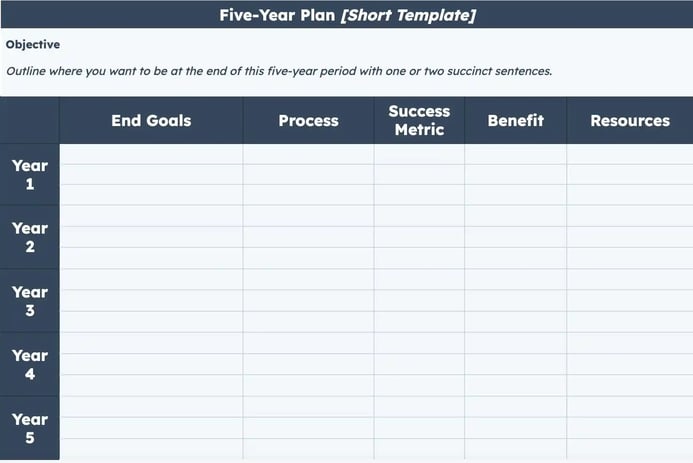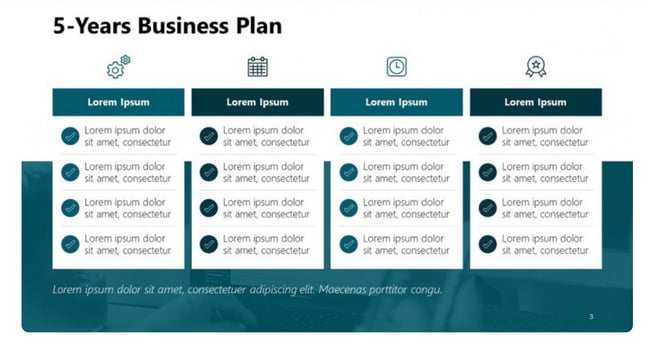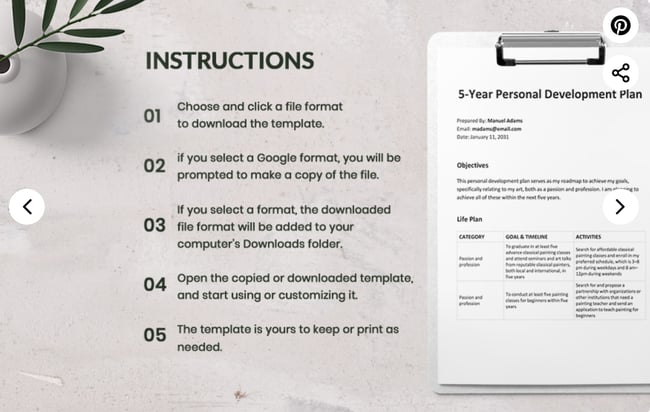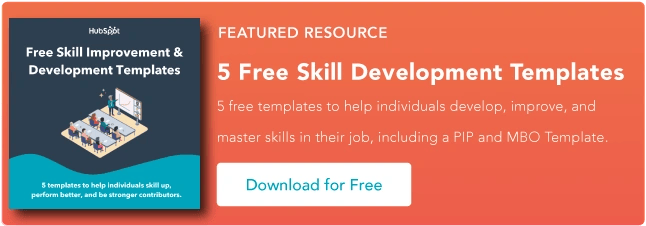One common question you’ll get asked in an interview is, “Where do you see yourself in five years?“
When it’s coming from a hiring manager, we usually have an answer ready. When it comes to your personal life, do you have a five-year plan?
 In the most stressful times in my life, planning brings me great joy and peace. But who says you have to wait for the stress to come? In this article, we’ll outline why you should create a five-year plan and how to build one you’ll follow through with.
In the most stressful times in my life, planning brings me great joy and peace. But who says you have to wait for the stress to come? In this article, we’ll outline why you should create a five-year plan and how to build one you’ll follow through with.
What is a 5-year plan?
A five-year plan is an outline of professional and/or personal goals you want to reach within the next five years. It usually includes broad goals relating to career, relationships, health, and finances that are broken down into action items and milestones.
Benefits of a 5-Year Plan
Whether professional or personal, a five-year plan can serve as a reset for your life. Who doesn’t like a fresh start?
After all, that’s why New Year’s resolutions are so popular. They give us something to look forward to. There’s also something to be said about writing out a detailed plan. It can be a great motivator to put something in motion.
Personally, I’ve said countless times that I want to be fluent in Spanish. However, it’s not until I write a detailed plan for how that it will become real.
This brings us to our next point: clarity. Sometimes, a path seems scarier than it actually is because we don’t actually know what it looks like.
Creating a plan is like pointing a flashlight in a dark road. A more accurate description is that it turns that dark, twisty road into a clear path forward. Doesn’t mean there won’t be any bumps in the road but at least you’ll know exactly where you’ll land and how to get there.
Lastly, a five-year plan can serve as a reminder of what’s at stake. In your daily life, it can be easy to forget that every day, we’re shaping our future.
The decisions we make today affect what our life will look like years from now. Having a visual reminder of this can keep you focused on your goals.
What to Cover in a 5-Year Plan
Before you get started with your plan, there are a few things you’ll need to figure out ahead of time.
1. Determine areas of focus.
Your five-year plan can cover various areas from education, career development, finance, hobbies, or even health. It’s up to you. Don’t feel stuck having to stick to one category and choose the ones that best interest you and fit your needs.
2. Write down your values.
Putting down your values in writing will help you discover your “why” (more on that later). This step will also help you narrow down what’s most important to you and shape the goals you set for yourself.
3. Research the path to your goals.
Your five-year plan is only as successful as the effort put into creating it. In order to create a viable plan it has to be actionable. Once you’ve got an idea of the goals you’d like to include, start researching the path to attaining them.
For example, if you’d like to set a career goal to become a marketing director, start looking at the steps and credentials required. Do you need to skill up? Is there a pathway at your current job? Doing some initial research will set you up for success.
4. Decide if you’d like to include HARD goals.
Tackling heartfelt, animated, required, and difficult (HARD) goals can be a rewarding but challenging part of a five-year plan. These types of goals will push you out of your comfort zone and help you achieve things you didn’t think were possible before. Think of these goals as highly ambitious but achievable with a five-year timeline.
Think of HARD goals this way:
Heartfelt: What reasons are behind achieving this goal?
Animated: What gets you excited about achieving this goal? Get specific.
Required: What is it going to take to achieve this goal? What will you need to accomplish in six months to a year to stay on track?
Difficult: What skills will you need to accomplish this goal and how will you obtain them?
Now that we’ve covered the groundwork, we’ve got more tips to help you create a five-year plan that keeps you motivated and inspired.
5-year Plan Tips
If creating a plan from scratch makes your eyes glaze over, check out these tips to help you start getting some ideas on paper.
1. Give yourself space to brainstorm.
To help you focus better when creating your plan, do a bit of pre-work. Give yourself time to really think about what you’d like to accomplish and the things that are most important to you. For example, you could write out a list of potential goals or ideas, and then rank them in order of importance — including notes about why they are important.
2. Consider separating long-term and short-term goals.
Once you’ve jotted down some goals, decide which are better suited for short or long-term ones. For example, completely paying off debt might be a long-term goal, but deciding which debt to tackle first could be a short-term goal. It may also help to divide them up into a 30-60-90 day plan to help best set a timeline.
3. Break down annual goals into monthly ones.
Tackling lofty goals can be overwhelming. This is why it’s important to break them down into smaller tasks that are manageable so you don’t get discouraged along the way. Let’s say you want to save $10,000 in a year. You can break that amount down into a recurring monthly payment of $833 or even split it into smaller weekly payments.
4. Find an accountability partner.
Sometimes life gets in the way and throws us curve balls — greatly impacting our ability to stay motivated and consistent. Having an accountability partner can help you stay on track. This could be someone you check in with monthly, a close friend, a family member, or a mentor. Whoever you choose, just make sure it’s someone who will keep you honest. Perhaps they’ll even have their own 5 year plan and you can take this journey together.
5. Don’t be afraid to make adjustments.
Remember that your five-year plan is yours. You can make adjustments as you see fit once you start tracking your progress. If your priorities change, update your plan.
5-Year Plan Template
If you’re ready to create your own five-year plan, we’ve got you covered.
HubSpot created the following five-year plan template for you to download.
In it, you’ll find a short and long version, both designed to help you break down your plan into actionable goals for each year.
Download this five-year plan template
Next, let’s dive into how to fill out your plan.
How to Make a 5-Year Plan
1. Know your “why.”
This is singlehandedly the most important step in creating a plan.
A clear “why” is your North star. It’s what will guide you throughout your journey and motivate you to keep moving forward.
It can take a while to narrow this down. You’ll know you have the answer when it’s linked to a core value or belief. Otherwise, you have to keep digging.
One way to get to this is by just asking the question over and over again. For instance:
- I want to learn American Sign Language. Why?
- To become more connected to another culture. Why?
- To broaden my perspective. Why?
- To be a more understanding, tolerant, and inclusive person.
Now, we’ve taken something at surface level and brought it down to a personal, human level.
2. Choose your objective.
When creating a five-year plan, you want to review your life as a whole and decide what your objective will be.
Are you focusing on your professional career, your financial goals, or your spiritual growth? Or perhaps you’re taking a more holistic approach and combining all of these elements.
If you don’t know where to start, use this: “In five years, I want to be [fill in the blank].” This will help you figure out goals that you may not have vocalized before.
Here are four core pillars you should always consider:
- Career
- Health (physical and mental)
- Finances
- Relationships (with self and others)
Depending on your goals, you can also add categories for religious or spiritual development, recreation, and service.
Don’t forget bucket-list items – have you been wanting to learn a new language? Or perhaps you want to visit every country in the world. Bucket list items are perfect for five-year plans because you can spread them out over a long period of time and have fun tracking your progress.
3. Start with the big ideas then narrow your focus.
When you’re first writing your five-year plan, start with an end goal for each year.
From there, break it down by:
- Process: What steps will you take to meet this end goal?
- Success metric: How will you gauge success?
- Benefit: How does this end goal bring you closer to your five-year plan?
- Resources: Which resources will you leverage to achieve your goal?
This process will help you turn your broad ideas into clear action items that can be executed.
Research will play a big role in this, as you will need to identify resources and set a structure to meet your goal.
For instance, say your five-year financial plan is to be debt-free.
That’s the big idea but you need to dive deeper. How exactly will you achieve that? Your research will likely suggest setting a budget, paying off your most expensive loan first, consolidating your debts, and more.
Once you know the key action items, you can break them down by year.
This is a S.M.A.R.T. goal in action. The more specific you are, the better you will be at fulfilling your five-year plan.
More on that in the next section.
4. Make it S.M.A.R.T.
To give you the best chances of success, every goal should pass the SMART test. That means being:
- Specific – The vaguer your goal, the harder it will be to reach.
- Measurable – You must be able to quantify your goals because otherwise, how will you know you’ve reached it? This doesn’t always mean assigning a figure to it, it can also be a feeling.
- Achievable – While it’s good to push yourself beyond your limits, your goal should be attainable and realistic based on where you stand currently.
- Relevant – How does this goal fit within the bigger picture? Does it align with your personal values? What’s the impact on your life?
- Time-bound – It’s not enough to say it’s a five-year plan, you have to create a timeline and set milestones at specific points within your journey.
5-Year Plan Common Mistakes
We’ve covered what to do and best practices. Next let’s talk about what not to do. Here are some five-year plan pitfalls to avoid.
1. Not setting clear goals.
If your goals are vague, it’s going to be nearly impossible to hit them. You can’t accomplish a goal that’s not clearly defined. When it comes to setting your five-year plan, specifics are key.
2. Not doing enough research.
If you’ve set any formal education or career goals, thoroughly researching requirements is a must. Skipping this step could cause you to miss important prerequisites and derail your goals completely.
3. Failing to set a timeline.
To achieve your goals you must track them. In order to track your progress, you need deadlines in place. Without deadlines you run the risk of aimlessly moving along (or not at all) without hitting important milestones — hindering you from accomplishing long-term goals.
4. Keeping a rigid plan that no longer suits you.
Yes, staying on task with your plan is important, but it is meant to serve you. If the plan you originally set no longer suits your needs, it is perfectly fine to make adjustments. The plan is not set in stone and it should be revised as needed.
Now that we’ve covered our bases, let’s look at some plan examples and templates to help you quickly get started on your own
5-Year Plan Example
Don’t let the task of creating a plan from scratch in Excel put you off. There’s plenty of ready-to-use templates that will make light work of formatting so you can focus on hitting your goals.
1. HubSpot
Best for: Personal or Professional Use
Using our downloadable five-year plan template, we were able to create a detailed five-year plan, broken down by year, process, success metric, benefit, and resources.
2.24 Slides
Best for: Professional Use
If you’re looking to create a more visual plan to help you stay on track, 24 Slides has an easy-to-customize 5-year business plan template. This template has space to include both short and long-term business goals, plus it includes a variety of charts to help you build an engaging presentation. It’s a good option if you’d like to create a 5-year plan that can be presented to stakeholders within the company.
3.Template.Net
Best for: Personal use
This personal 5-year personal development plan from Template.Net offers a quick way to jot down your goals and strategize how to achieve them. The categories are simple: objective, goals, timeline and activities, and has additional space for you to write out any reminders you’d like to set. Be sure to include your “why” in the objective section to keep your reasons for creating the plan top of mind.
Accomplish More With a Plan
If you want to add more structure to your life and play a more active role in shaping your future, consider creating a five-year plan. While things may not pan out exactly as you’ve expected, you’ll be surprised at how close you’ll get to what you wished for.
Editor’s note: This article was originally published in May 2022 and has been updated for comprehensiveness.

-jpg.jpeg?width=600&name=worst%20resume%20fonts%20script%20(2)-jpg.jpeg)



![How to Create a 5-Year Plan You’ll Actually Stick To [In 4 Steps]](https://blog.hubspot.com/hubfs/seo%20tips.png#keepProtocol)
![How to Create a 5-Year Plan You’ll Actually Stick To [In 4 Steps]](https://blog.hubspot.com/hubfs/kickoffmeeting.webp#keepProtocol)
![How to Optimize for Google’s Featured Snippets [Updated for 2024]](https://moz.com/images/blog/Blog-OG-images/How-to-Optimize-for-Googles-Featured-Snippets-OG-Image.png?w=1200&h=630&q=82&auto=format&fit=crop&dm=1724004002&s=13df73104762982790dab6dc8328023f)


